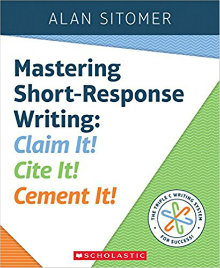A System to Teach Short-Response Writing
Mastering Short-Response Writing: Claim It! Cite It! Cement It!
By Alan Sitomer
(Scholastic, 2016 – Learn more)

Phew! I don’t know about the rest of you, but we have just come off a month of rigorous state testing. It can be a struggle to watch kids take tests that may not always be the best representation of their potential.

Yet, despite our efforts, some of our students still really struggle to do well, especially on writing tasks that require they support an idea with solid evidence and reasoning. And this problem isn’t just showing up on our tests – the good work we are doing in ELA is also not transferring to our content area classrooms.
So what do we do? How do we help kids who are struggling to develop an idea with strong evidence and solid reasoning? We pull out “…a common sense tool for common sense instruction…” I have found Mastering Short-Response Writing: Claim It! Cite It! Cement It! by Alan Sitomer to be just that tool.
Newsflash! We live in a short-response world!
Sitomer points out early on the importance of teaching kids how to construct well-written short responses. We live in a world that requires short-response writing: “from emails to cross-curricular writing tasks to social media posts to standardized tests and assessments across the disciplines, short response rules the day.”
Yet, he contends, many of our students are not even capable of writing well-developed sentences and paragraphs. According to Sitomer, “one of the foremost problems we have when it comes to teaching students to write is self-evident: we are incessantly asking students to write long, multi-paragraph essays when it is clear that our students do not have the skills necessary to compose well-written short responses.”
After years of working with struggling readers and writers, he finally found something that worked, and thus The Triple C Writing System was born and is outlined in his book.
Mastering Short-Response Writing with the Triple C’s
Alan Sitomer calls his process Triple C – Claim It! Cite It! Cement It! Simply put, students learn to make a claim, support it with strong evidence, and connect the evidence to the claim through reasoning to create a strong, short-response piece.
Using a gradual release of responsibility model, the book walks you through the process of teaching kids how to develop expository or argumentative short responses one sentence at a time. Sitomer’s straight-forward, easy-to-follow structure makes it useful for novice and veteran teachers alike.
Effective Teaching
Through Sitomer’s writing system, students are explicitly taught a student-friendly definition of each of the Triple Cs and then scaffolded through the work. Each chapter is broken into six action steps:
- Determine a baseline
- Define the concept
- Demonstrate instruction through modeled lessons and think alouds
- Guided/independent practice
- Demonstration of revisions strategies
- More guided/independent practice
Sitomer walks you through each action step with clear examples, ideas for extending the learning, formative assessment ideas, and tools to support the writer such as sentence stems and self-assessment rubrics.
He also includes ideas for embedding lessons in grammar and conventions as well as tips for elevating the performance as students master each C. Sitomer even includes a chapter on providing productive feedback and a clear explanation of Doug Fisher and Nancy Frey’s Gradual Release of Responsibility Model.
It Works!
After reading this book, I immediately condensed the pages into a few quick guides to use for instruction and took it to my students. I discovered very quickly that Sitomer was right. I had assumed my kids new a lot about argumentative writing when in fact they were struggling to write solid claim statements.
After starting with examples from the book, I wanted to see how they would work with writing about reading. So I adapted the lessons slightly and wrote some of my own claim statements using a mentor text. I then asked kids to write several claim statements off of picture books before going back to their novels.
And I must say, it worked. Students were finally writing claims that they could support, and that were clear and explicit. I am excited to continue the work with my students as we delve into Cite It! and Cement It! And I expect to see the success continue. I am even more excited to see the impact on all our middle school students as I share my learning with my colleagues.
Worth the Cost
Once I picked up Mastering Short Response Writing: Claim It! Cite It! Cement It!, I couldn’t put it down. The book is a quick read with practical ideas that can be implemented tomorrow. The Triple C Writing System is proving effective with my struggling writers and is easily adaptable to literary essays. The lessons could easily stand alone as a unit on writing strong short responses, or they could be integrated into an existing content unit that requires short-response writing. I also find it highly useful as an intervention resource.
Alan Sitomer has a winner with this book. Pick it up today, and start improving your students’ writing tomorrow.
Amber Bartlein is a K-8 literacy coach and special education teacher. She has worked closely with districts to support the implementation of reading and writing workshops, high quality interventions, and differentiation for all students. She lives a busy life in Wisconsin with her husband and five children but enjoys finding time to keep learning each day.




































Amber, this sounds like a wonderful, practical book. I especially like your idea of using picture books!